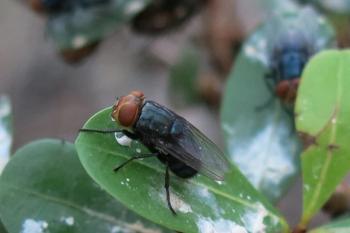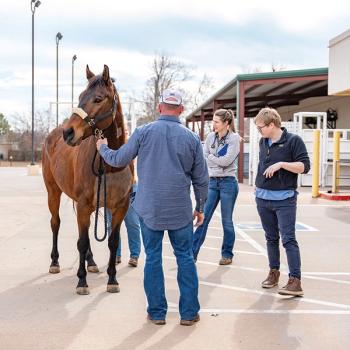
GAO: Neglect on the rise since closure of domestic equine slaughter operations
National Report - The welfare of some horses has declined since the United States banned equine slaughter plants, according to a new report by the Government Accountability Office (GAO).
NATIONAL REPORT — The welfare of some horses has declined since the United States banned equine slaughter plants, according to a new report by the Government Accountability Office (GAO).
Why? Because financially strained owners are sending horses longer distances to foreign plants that may or may not honor humane slaughter guidelines.
"The prohibition on the use of funds for required inspections has, in effect, banned the slaughter of horses for food in the United States, and, as a consequence, moved this slaughter to other countries where (the U.S. Department of Agriculture) lacks jurisdiction and where the Humane Methods of Slaughter Act does not apply," the report states. "Therefore, USDA is less able to ensure the welfare of horses at slaughter. And, as was the case with horses in transit to slaughter, (USDA's Animal and Plant Health Inspection Service) officials speculated that compliance with the transport regulation has suffered because shippers are aware that the program can no longer leverage the assistance of USDA personnel in slaughtering facilities to ensure the completion of paperwork or note the condition of individual horses in a shipment."
Horses now travel at least 200 miles further to slaughter than they did when domestic facilities were operating, GAO estimates.
Horse exports for slaughter to Canada and Mexico increased by 148 percent and 660 percent, respectively, from 2006 to 2010. While officials estimate a total of about 138,000 horses were sent to slaughter at four facilities in Canada and three in Mexico, the numbers could be higher, GAO says, when you factor in transport of feeder horses. These horses are sent to feedlots in Canada and Mexico to be fattened up and sent to slaughter later. USDA estimates that another 30,000 horses were exported from the United States in 2010 for other purposes than slaughter.
The number of horses slaughtered domestically had decreased from almost 350,000 in 1990 to about 42,000 in 2002, but began rising again in 2003 to reach the estimated 105,000 animals slaughtered at two plants in Texas and Illinois in 2006—the last full year of domestic horse slaughter. Another 33,000 were shipped for slaughter in Canada and Mexico that same year, resulting in about the same total number of American horses slaughtered in 2006 (137,688) and in 2010 (137,984), according to the GAO report.
Regulators, animal-welfare organizations, representatives from the livestock industry and 17 state veterinarians were among those interviewed for the report, and while there is little hard data on horse abandonment, neglect and abuse, the consensus on the state of equine welfare was clear, GAO says.
"Without exception, these officials reported that horse welfare has generally declined as evidenced by a reported increase in cases of horse abandonment and neglect," the report states.
Dr. William Moyer, president of the American Association of Equine Practitioners (AAEP), says the unintended consequences were anticipated as outlined in the report some time ago.
"(Slaughter) is obviously not the ideal way to manage this, but by the same token, at least when it was done in that way ... it was done in a very highly regulated system. Once that ended, these horses and their owners are subject to whatever takes place when they cross the border.
"Across the board, those of us that work on horses have seen an increase in neglect and abuse problems and obviously this is one of the consequences. Clearly the down economy is a factor," Moyer says, adding that he thinks equine welfare in the United States is in a state like never before, with horses being dumped on public and tribal lands, or just abandoned.
"Those are happenings, at least in my lifetime, I don't recall seeing or hearing."
Abuse, neglect and horse prices
In Colorado alone, investigations of horse neglect and abuse increased by more than 60 percent from 2005 to 2010, according to GAO. California, Texas and Florida also reported more cases of abandonment since the closure of slaughter facilities in 2007.
Abuse in most cases is not direct or planned, the report notes, but a result of the lower horse prices caused by cessation of domestic slaughter and the economic downturn. Fewer horse sales and auctions have taken place since 2007, report the state veterinarians interviewed by GAO. They attribute that decline in part to lower horse prices and sales commissions since the cessation of domestic slaughter. An 8 percent to 21 percent drop depending on the class of horse has been attributed to the cessation of domestic slaughter, whereas only a 5 percent decline across all horse-class categories is traced back to the economic downturn, GAO says.
Humane groups that pushed for the closure of domestic slaughter facilities say, in the wake of the report's findings, that there are options available to horse owners in dire straits without resorting to slaughter, neglect or abandonment.
"This situation can only be resolved by greater outreach and information about the private responsibilities and expense of horse ownership, and the options available to struggling horse owners such as adoptions and rescue groups," says Michael Markarian, president of the Humane Society Legislative Fund.
Yet the GAO report notes that horse adoptions have dwindled and even rescue groups are challenged to meet the need presented by the growing numbers of unwanted horses.
"Officials said horse rescue operations in their states are at, or near, maximum capacity, with some taking on more than they can properly care for since the cessation of domestic slaughter," GAO reports. "State veterinarians also described situations in which counties and sheriff departments were reluctant to investigate reports of abandoned or neglected horses because these jurisdictions lacked resources."
The Humane Society of the United States contends that abandonments happened before the cessation of domestic slaughter, too, and that owners who choose to abandon horses will do so whether they have the option of domestic slaughter or not. Additionally, HSUS points out that there is no good data on horse abandonments, but says the abandonment of all types of domesticated animals has increased as the economy worsened.
Regulators hands are tied
The USDA's Slaughter Horse Transport Program, established in 2001, continues to operate despite the ban on domestic slaughter operations. However, there is little regulators can do to enforce the intent of the program, which is aimed at ensuring horses intended for slaughter are fit to travel and handled humanely along the way.
The prohibition against using federal funds for inspecting horses destined for slaughter—recently renewed since the initial 2006 action—means the transport program may not inspect the condition of horses headed to slaughter. Instead, they may only collect and review shipping documents and inspect the conveyances used to transport the horses, GAO says.
A report from USDA's Office of the Inspector General in September called on APHIS to improve controls for the humane shipment of horses to slaughter, citing deficiencies in the agency's tracking and investigation protocols.
"The only thing they can do under the present situation when they hit the border is to just look at the papers," Moyer explains. "There's an absence of any inspection at that point because of the legislation. There's no teeth in it because the dollars to inspect it were removed."
There isn't a clear picture of how many horses are crossing the borders into Canada and Mexico for slaughter, since USDA depends on numbers from regulators in both those countries for the tally, GAO reports. Some agreements are in place to get information about horses being shipped for slaughter, but they are not always followed, and there are few resources for enforcement. A 2007 rule proposed by APHIS to protect horses during transport has been delayed, too.
"With cessation of domestic slaughter, USDA lacks staff and resources at the borders and foreign slaughtering facilities that it once had in domestic facilities to help identify problems with shipping paperwork or the condition of horses before they were slaughtered," the report concludes.
In 2005, APHIS stopped entering information from shipping certificates into an automated database, says GAO, making it more difficult for the agency to identify potential violations.
GAO found that from 2005 through 2009, 29 percent of the shipping certificates collected by the Canadian Food Inspection Agency (CFIA) and returned to APHIS were missing some or all of the information to be provided at the slaughtering facility. Reporting decreased over time, GAO notes, with 48 percent of shipping certificates missing key information from 2005 to 2006, and 60 percent from 2008 to 2009.
Reporting from Mexican regulators is not much better, GAO says, with 48 percent of certificates missing key information from 2005 to 2006 and 54 percent from 2008 to 2009. Nearly 40 percent of the shipping certificates turned into APHIS from authorities in Mexico were missing some or all of the information required, including the date and time horses were unloaded at the border, GAO says.
Domestic counts aren't being reported, either, GAO says. As of March 2011, USDA APHIS had not received any shipping certificates from Texas border crossings in more than a year, even though the majority of horses bound for Mexico pass through the state.
New changes could add more challenges
Canada and Mexico, throughout 2009 and 2010, began placing new restrictions on horses imported for slaughter, requiring documentation that the horses were free of certain medications for a specified period prior to shipping. In 2013, the European Union (EU), a chief importer of horsemeat for human consumption, will start requiring lifetime drug records for all horses slaughtered in non-EU countries before accepting their meat for human consumption.
Additionally, a federal bill introduced in the U.S. Senate could ban the export of horses bound for slaughter for human consumption all together.
The American Horse Slaughter Prevention of Equine Cruelty Act of 2011 (SB 1176) would amend the Horse Protection Act to prohibit the interstate or foreign sale or transport of horses for the purpose of processing them for human consumption.
HSUS supports the legislation, saying that 92 percent of horses sent to slaughter are in good condition and could lead healthy, productive lives.
"This bill could finally take American horses off the menu for good, and put an end to shocking and inhumane treatment of these animals," says Wayne Pacelle, president and chief executive officer of HSUS.
HSUS says a national poll indicates that 70 percent of Americans favor a ban on horse slaughter, but Moyer says legislation that gives horse owners even fewer options for dealing with unwanted horses may only make matters worse.
While veterinarians want to be at the forefront of animal welfare debates such as this, Moyer believes the profession end up in a difficult position by trying to navigate between public perception and what is in the animal's best interest.
"It's part of that whole societal dilemma. We've got a percentage of population in the United States that think beef comes from a wrapper. A big percentage of the population is urban and simply does not know what it is involved in caring for horses and livestock," he says. "It becomes one of those issues where, because of lack of understanding of what takes place in the animal world, you could come out looking like that bad guy."
Without more resources for dealing with the growing number of unwanted horses, Moyer says he fears equine welfare would suffer even more should the new legislation be enacted
"If Congress pursues the option of banning the processing of U.S. horses without appropriate funding and infrastructure in place to appropriately care for these animals, this action may only amplify the negative welfare implications for this highly vulnerable population of horses," Moyer says.
The next step
GAO suggests both banning domestic slaughter and the exportation of horses for foreign slaughter completely, and once again allowing domestic slaughter as solutions to the equine welfare crisis. Without giving a clear recommendation either way, GAO recommends actions be taken to better protect the welfare of horses transported to slaughter, including issuing a final rule to give USDA more enforcement power, using other agencies to better assure the completion of shipping certificates, and securing agreements for better slaughterhouse reporting from Canadian and Mexican authorities.
"Our recommendation on this is pretty clear—the USDA needs to be funded in order to manage this transportation situation. There has to be some mechanism put into place where we could be reasonably assured that the welfare of these animals is being handled properly," Moyer says.
"The lack of federal funding for the USDA's transport oversight program cripples the agency's ability to properly protect horses that are shipped to processing facilities," he adds, speaking for AAEP. "Our association supports the return of funding to the USDA. The AAEP feels it is equally important that the USDA quickly issues its final rule on transport regulations so the agency's oversight will extend to more of the transportation chain."
HSUS, on the other hand, supports the all-out ban on horse slaughter, blaming "the agribusiness lobby and some veterinarians aligned with industry" for blocking attempts to stop long-distance transportation of horses to slaughter.
"When a handful of slaughter plants did operate in the U.S., horse still traveled long distances across the country ... and the transport and slaughter processes involved were inherently inhumane," says Markarian. "There's no reason to believe that slaughter plants would spring up in every community to make the transport distances shorter."
As of press time, SB 1176 had been read twice and referred to the Senate Committee on Commerce, Science and Transportation, and USDA had pledged to GAO to move forward on efforts to publish a final rule on equine transportation regulations.
Newsletter
From exam room tips to practice management insights, get trusted veterinary news delivered straight to your inbox—subscribe to dvm360.






